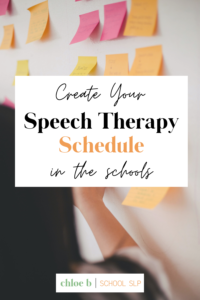One of the craziest parts of our speech-language pathologist jobs in a school setting is trying to make a schedule. It legitamitely feels like tetris sometimes! There are lots of ways you can do it, but I’ve developed a system over the years to make scheduling speech therapy students a little easier.
My system is definitely not perfect, and I highly recommend you tweaking these steps to make it work for you! I’ve also included links to the FREE scheduling tools I created and use!

Step 1: Decide on Type of Schedule
What kind of schedule do you need to make? Will you have a rotating schedule? Block scheduling?
Will you reserve Fridays completely for testing/meetings/paperwork or will you scatter that time throughout the week?
If you’re thinking you have noooo idea or preference – don’t worry! You don’t have to make this decision right away! You can keep going through the other steps and come back to this as you get more info to build your schedule!
Typically I try to reserve Fridays, but sometimes I have duty or need to schedule sessions on that day. So no worries – this whole scheduling process is all about FLEXIBILITY! We can, and will, make a million changes as we go!
Important Note: You may want to do the entire scheduling process WITH the other professionals that pull your kids. For example, I have to make a schedule that accommodates resource teachers, interventionists, ELL paraprofessionals, OT/PT, etc.
Another possibility is to create your *flexible* schedule, bring it to them to compare, and then make adjustments as needed!
Step 2: Prepare Your Supplies
Here’s where I got some FREEBIES for you!
I made a sticky-note friendly schedule template that you can also laminate and use dry erase markers! You could also use the template digitally using any PDF editor like Kami!
So here’s what you’ll need –
- These templates
- Sticky notes and/or dry erase markers
- Writing utensils
- Caseload list
Step 3: Lock in Any Non-Negotiables
What are your non-negotiables that need to be locked down into your schedule right away?
For me, I have a few things that I put in my schedule first to prevent over booking. I have two lunch duties plus a PLC team meeting weekly.
Some people prefer to lockdown a lunch and/or planning time as well. I personally choose to keep those times flexibile based on the other steps while keeping in mind that they are necessary and things may need to shift at the end to accommodate their inclusion on the schedule.
Step 4: Ask Teachers for Top 3 Preferred Times
**You may want to do step 5 before step 4 – whatever makes sense to you!
Classroom teachers know their schedules and know when good times would be to pull their students. Every grade is definitely different, and sometimes even teachers within the same grade level can have different opinions. It is impossible to please everyone, but we can try to make the times as ideal as possible! You can email everyone at once and do it on a first come first served basis, or ask teachers individually as you please.
Personally, I individually ask teachers for 3 time slots ranked by preference. Not everyone will get their first choice, but more on that later.
This year, I will also be getting ideal times for push-in therapy. This will obviously be different then the times for pull-out therapy, but it works for me and my rotating schedule. For pull-out therapy times, I aim for times when students are being pulled in small groups or working independently. For push-in therapy times, I like to see them as they work whole-group, in groups with peers, etc.
Step 5: Create Student Groups & Plug Them In
How do you want to group your students together? Do you have some students that need to be indivdual? Push-in?
I typically try to group my students by goals (language groups, artic groups, etc.) but there are benefits to mixed groups as well! I also aim to keep students together by grade/teacher as much as possible. It is important to think about personality types, behavior issues, etc.
Remember – we can always make changes! Scheduling speech therapy students means lots of changes!
I like to write names or initials on a sticky note for each group. If they will be seen twice a week, then that group will be on 2 sticky notes.
Once you have all of your kids on sticky notes, you can start plugging them in!
Step 6: Plug In Each Group Into an Open Time Slot
This is where things start to get a little hairy. It may be best to plug students in on a first come first served basis if you asked all of the teachers at the same time. In my school, we have a harder time scheduling older students compared to younger students due to class structure. As a result, I often give a slot to an upper grade group if it’s coveted by more than one grade. Do what works best for you and your building(s)!
Since you’re using sticky notes or dry erase – you can change this again and again until you find something that works!
Step 7: Compare with Others & Keep Adjusting!
If you didn’t complete this process with the other professionals in your building that pull students, then now would be the time to compare schedules! You can work on your compromising skills if you and another staff member have double booked a student for the same time!
More than likely, your schedule will change SEVERAL times before it is completely finalized. I like to spend the first two weeks of school with this rough draft sticky note version of my schedule before I type it all up. That way it is super easy to make changes as needed!
There you have it! Seven steps to scheduling speech therapy students! Are there any steps that I missed? Let me know in the comments!
-Chloe B | School SLP
Looking for more Back to School related blog posts? Check out First Day of Speech Therapy Activities!








One Response